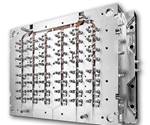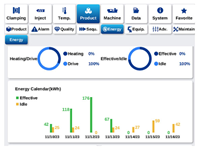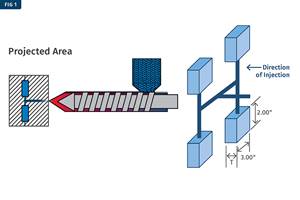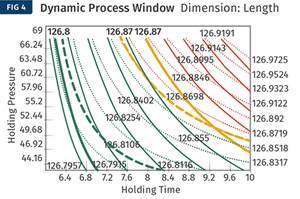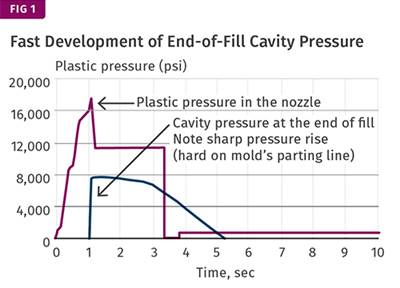Screw Bounce — What Causes It and Why You Should Care
There are a lot of theories about screw bounce in injection molding it, but what’s the actual cause? Through a series of experiments, and some good old-fashioned math, the author found out.
Every processor has probably seen, debated and most likely dismissed what is commonly referred to as “screw bounce.” Screw bounce often happens as the machine transfers from first to second stage and, despite it happening with nearly every molding process to some extent, its root cause and potential impact on the molding process and parts did not seem to be well understood until recently.
The American Injection Molding (AIM) Institute’s research on screw bounce detailed here actually resulted from what seemed to be a relatively simple question asked by one of our students in our Molding 2 course. This course teaches molders how to develop, document and defend their molding process.
To aid in the process development strategies and bring more science to the molding process, we developed mathematical equations that give our students the ability to calculate values for shot-size setting and transfer position. The intent is to determine a safe amount of material to inject into the mold during first stage with little to no risk of putting too much or too little plastic into the mold on the first shots. We call this our “safe start-up shot size.” It is primarily based on melt density and a desired shot volume, along with an additional safety factor to finish filling and packing the part while providing enough material for a cushion.
The theory we were developing was that when the machine transfers from first stage to second stage, that short delay enables the material to uncompress backward inside the barrel.
I originally developed the safe start-up shot size concept almost 30 years ago when I was working at a Tier 2 automotive supplier. The reason for it was because our processors would often flash the mold or stick parts in their first few shots.
When I asked our lead processor why this kept happening, his response was simple: “I don’t even know what this mold is supposed to be making so I have no idea how much plastic to inject.” I took that to heart because I designed the mold and realized I was not giving our processors the shot volumes and other valuable pieces of information that were readily available. So, I started doing the math and giving them the safe start-up shot size on our initial sample instructions.
Fast forward a few decades, and we now use this approach at the AIM Institute. However, we quickly found out that the math often confused the processors, because the safe start-up shot size is not a setting that they would enter directly into the controller. It was a result of the shot size setting and transfer position, and determining that required additional math. So, we went back to the drawing board and reworked the math. We have since developed new math that enables the processors to calculate the “shot size setting” and the “initial transfer position” that they would then enter directly into the machine controller. We use the term “initial transfer position” because this method provides a shot volume that is X% (80% for example). The processor would later lower the transfer position to eventually develop a fill-only part that is approximately 95-99% full, per typical scientific molding guidelines.
However, we noticed that if we calculated an 80% shot volume, the molded part was often much less than 80% full. We dismissed this initially as variations in actual melt density versus a generic value, along with differences in part volume versus shot volume. As we explained this during a Molding 2 class, a student asked a question that started us down the R&D road: “How can we calculate more accurate values?” When asked to elaborate, the student said that if he did not get enough plastic into the mold, he would need to manually strip plastic off of a lot of cores because the stripper plates would not be able to eject the parts.
Challenge Accepted
I scheduled some R&D time in our lab to figure out the precise math and provide a better solution using measured melt densities. The intent was to mold fill-only parts and compare their actual weight to the theoretical weight. The math for the theoretical weight is shown below:
Theoretical Weight (g) = Shot Volume (cc) × Melt Density (g/cc)
Example (Polycarbonate)
Shot Volume = 11.17 cc
Melt Density from Moldflow = 1.06 g/cc
Melt Density Verified Using the Molding Machine = 1.06 g/cc
Theoretical Weight (g) = 11.17cc × 1.06 g/cc = 11.84g
We collected the data using the same shot volume for three different materials: PP, POM and PC. The first sample with PP showed a relatively small difference of 3.12%, when comparing theoretical versus actual weight. However, the difference grew to 12.64% and 15.54% when switching to POM and PC respectively (Figure 1). Our frustration set in as the math was not working, and we did not understand why.
FIG 1 — PP, POM and PC all showed variations in the theoretical and actual weights, but the differences were most stark in POM and PC. Source (all images): American Injection Molding Institute
We ran the studies again to verify the methodology and errors. However, when we ran the mold the second time, we hooked up a Kistler ComoNeo data acquisition system to the Sodick Plustech molding machine. When running the trials, Jason Travitz, our senior processor instructor, made a casual observation about the amount of screw bounce being detected on the screw position curve (Figure 2, line 2). We initially dismissed the screw bounce as something that we all know happens, and we didn’t think it would cause the error because the plunger was still reaching the transfer position and thereby injecting the same volume of material … or so we thought.

FIG 2 — Using a Kistler ComoNeo data acquisition system, researchers isolated the screw bounce.
The Theory
Early on in my career when I would ask people about screw bounce, I would hear a lot of random explanations, but no one seemed to have a solid understanding and justification as to why it happens. During a brainstorming session in which we tried to figure out why the math was not working, we came back to the observed screw bounce and coupled it with the compressibility of plastic materials. As for compressibility during molding, whenever I heard someone discuss that topic, it was always in the context that during injection the material gets compressed and then uncompresses forward as it continues to flow.
What if the material uncompressed backward instead of forward? After all, the majority of the compression is happening in the barrel of the molding machine where pressures are the highest. There would be little to no compression at the flow front because the pressure there is essentially zero. The theory we were developing was that when the machine transfers from first to second stage, that short delay enables the material to uncompress backward inside the barrel, and this uncompressing of the melt could be ultimately what is pushing the screw back and creating what we observe as “screw bounce.” In addition, if the material is uncompressing and pushing the screw back, that would mean there is less material going forward into the cavity. This would result in lighter parts, which is exactly what the data showed during the initial trials.
The more the material was being compressed, the larger the difference in theoretical versus actual weights.
To evaluate the compressibility of the materials, we turned to pressure-volume-temperature (PVT) data. When looking at the compressibility of each material at the injection pressure seen during the fill-only parts, a direct correlation was found between the degree of compressibility versus the percent difference in part weight predictions (Figure 3). The more the material was being compressed, the larger the difference in Theoretical versus Actual Weights.
FIG 3 — A direct correlation was seen between the degree of compressibility versus the percentage difference in part weight predictions.
We believed we had a solid theory on what was happening. To test the theory, we needed to eliminate screw bounce (Figure 4, line 2). We did that by adjusting our shot size setting and transfer position to enable the plunger to bottom out. But we also needed to hold the plunger forward by adding pack pressure. This would ensure that the entire volume of material we were injecting would in fact uncompress forward out of the nozzle and not backward inside the barrel.

FIG 4 — The researchers eliminated screw bounce by adjusting the shot size setting and transfer position, enabling the plunger to bottom out.
After completing the third round of studies, the percentage difference between theoretical and actual weight dropped to 0.95%, 0.22% and 0.31% for the PP, POM and PC materials, respectively (Figure 5). These studies showed the math does work, and we now have a better understanding of what is causing screw bounce.
FIG 5 — AIM dramatically closed the gap between the theoretical and actual weights, better accounting for screw bounce.
Other Influences
The amount of screw bounce and therefore the gap between theoretical and actual weights can be influenced by a number of factors, including the type of melt delivery system. Large hot runner systems will often show more of a discrepancy due to the larger amount of plastic melt volume in front of the screw that is being compressed.
For a given material, the amount of error will change based on different molds that require different injection pressures. As the pressure goes up or down, it will affect how much the material is being compressed and the resulting screw bounce and error in the calculations.
The studies also showed that for some materials studied, screw bounce may in fact be reduced or even eliminated as you go from a fill-only part to a fully packed part. This finding would imply that the first-stage fill-only part could now be different once you add pack pressure. This could also create challenges when trying to replicate the process on another molding machine that may have a different nozzle geometry and/or screw size (mass and momentum), which could influence the amount of compressibility in the material. Viscosity shifts also cause the injection pressure to vary, and thereby it would vary the amount of compressibility seen which will in turn change the fill-only parts as well.
In addition, the machine response may affect the amount of screw bounce. With the Sodick molding machine, we established a process with and without the utilization of its Pressure Drop Time (PDT) feature. This option enables the high pressure seen at the end of first stage to drop off gradually over time to the desired packing pressure. This results in a higher pressure on the plastic melt initially right after transfer and thereby potentially reduces or eliminates screw bounce. This will then produce two different fill-only parts using the same shot size setting and transfer position as shown in Figure 6.
FIG 6 — AIM utilized the Pressure Drop Time (PDT) feature on its Sodick Plustech machine to enable high pressure at the end of the first stage to drop gradually.
Compressibility at the Root
The research showed the root cause of screw bounce is tied to the material compressing and uncompressing as the machine transfers from first to second stage. It also showed that the molding math used to predict actual shot weight does work, so long as all the material you plan on injecting during first stage actually goes into the mold. The challenge for molders will be the unknown of how much screw bounce and resulting error in the calculations there will be for a given mold. As discussed earlier, the amount of compressibility, screw bounce and errors in shot-weight calculations are a result of the material, melt delivery system, injection pressure and machine response. So, the answer to the student’s question that started this R&D journey is not as easy as we had hoped, but we are further along now than we were before the research. As machine manufacturers continue to evolve their machine design to minimize or eliminate screw bounce with improved controls, the science behind injection molding will continue to improve.
Editor’s Note: The author would like to acknowledge the contributions of Jason Travitz, AIM’s senior process instructor, and Lucy Lenhardt, AIM’s molding lab manager, to the research that supported this article.
About the author: David Hoffman is the director and an instructor for the AIM Institute where he was instrumental in coordinating and developing its curriculum. He also is a contributing author to John Beaumont’s Runner & Gating Design Handbook. He previously served as the technical director of sales & marketing for Beaumont Technologies, and is co-inventor of its MeltFlipper MAX melt-rotation technology patent. Hoffman’s formal education includes an associate’s degree in mechanical engineering technology and a bachelor’s degree in plastics engineering technology from Penn State Erie. Contact 866-344-9694; dhoffman@aim.institute.
Related Content
Using Data to Pinpoint Cosmetic Defect Causes in Injection Molded Parts
Taking a step back and identifying the root cause of a cosmetic flaw can help molders focus on what corrective actions need to be taken.
Read MoreIs There a More Accurate Means to Calculate Tonnage?
Molders have long used the projected area of the parts and runner to guesstimate how much tonnage is required to mold a part without flash, but there’s a more precise methodology.
Read MoreUse These 7 Parameters to Unravel the Melt Temperature Mystery
Despite its integral role in a stable process and consistent parts, true melt temperature in injection molding can be an enigma. Learning more about these seven parameters may help you solve the puzzle.
Read MoreOptimizing Pack & Hold Times for Hot-Runner & Valve-Gated Molds
Using scientific procedures will help you put an end to all that time-consuming trial and error. Part 1 of 2.
Read MoreRead Next
How to Optimize Pack & Hold Times for Hot-Runner & Valve-Gated Molds
Applying a scientific method to what is typically a trial-and-error process. Part 2 of 2.
Read MoreINJECTION: First to Second Stage Transfer: Should There Be ‘Bounce-Back’?
How much screw ‘jumping’ or bounce-back can your process tolerate? The answer is no surprise: It depends
Read MoreNew Injection Screw Breaks the Rules, But Fixes Many Molding Defects
“Revolutionary” screw design turns conventional plastication theory upside down.
Read More